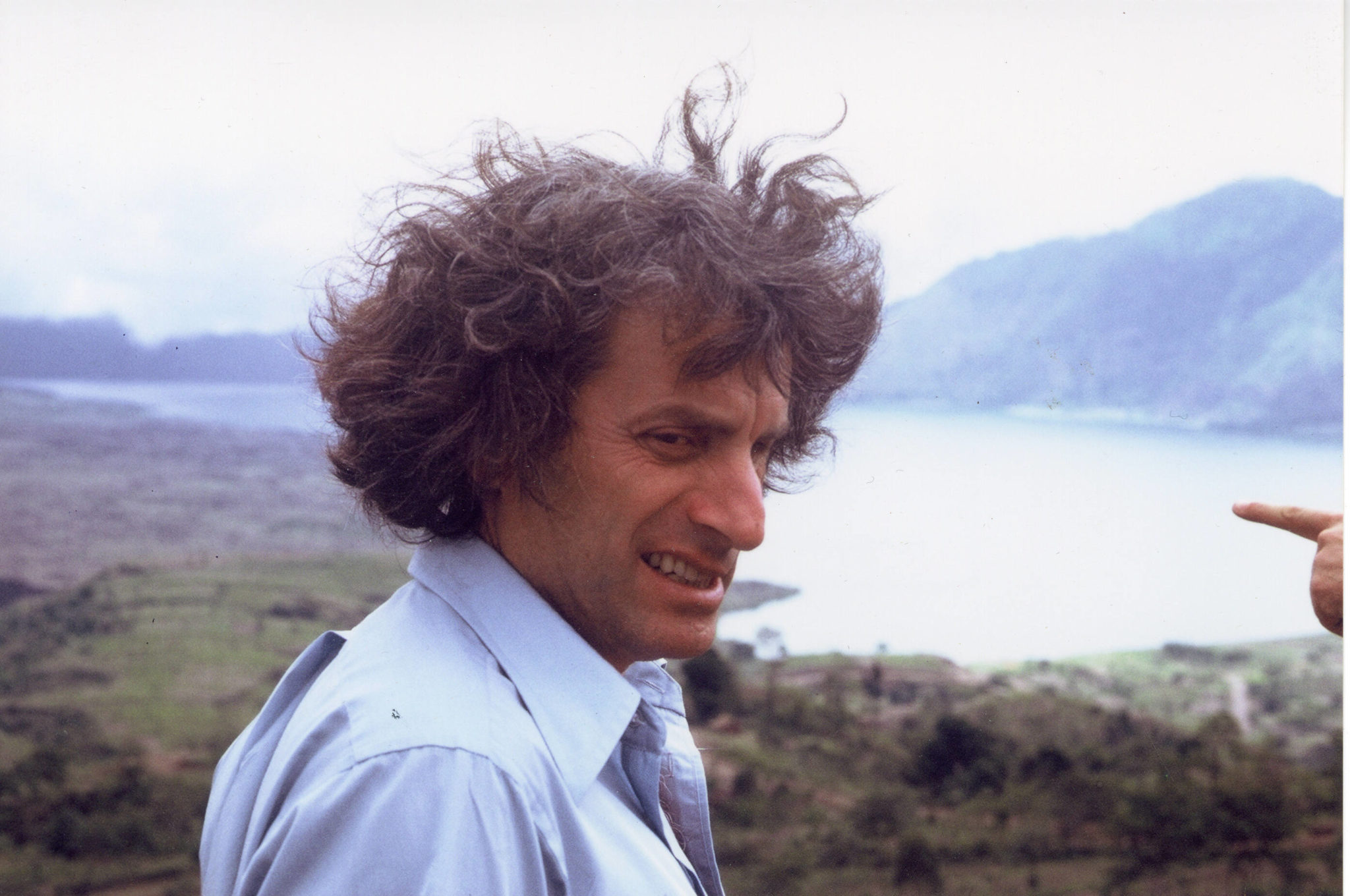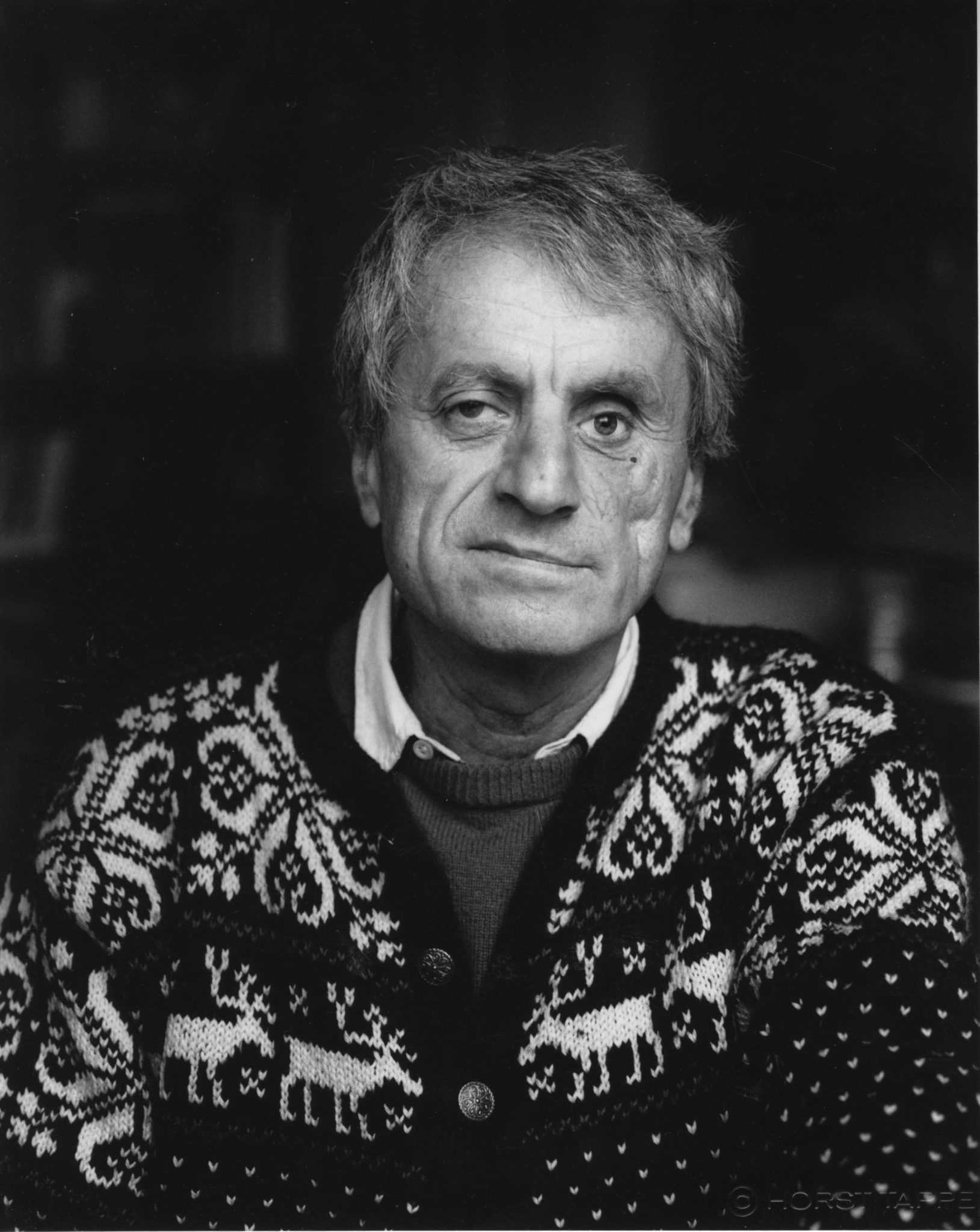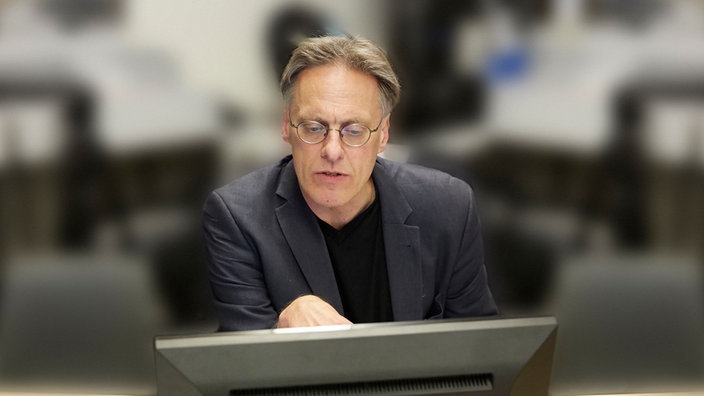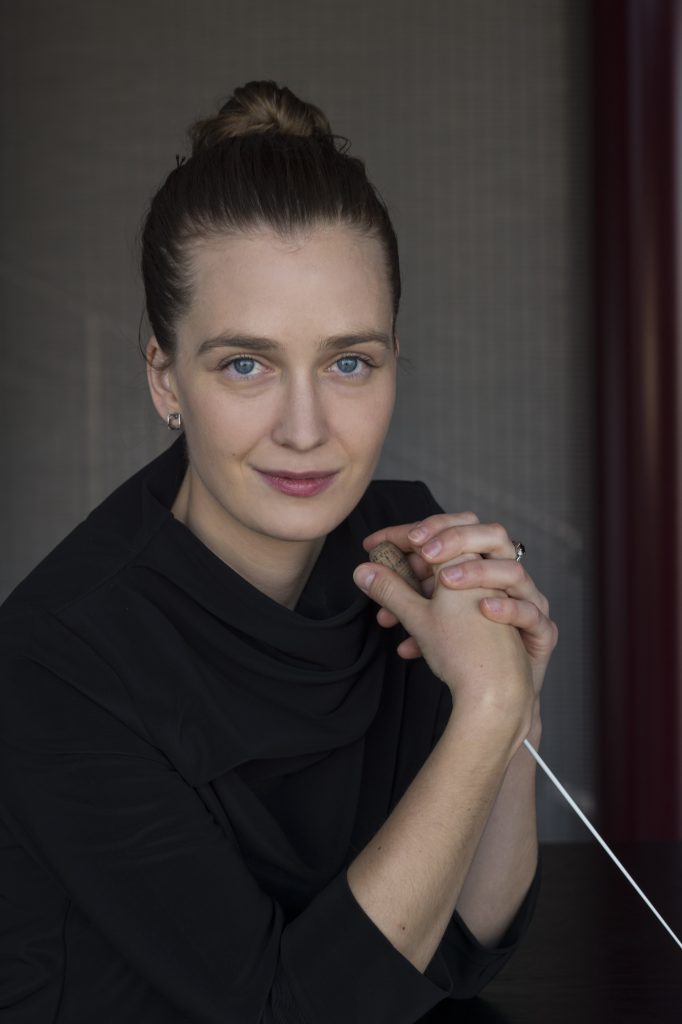CD Marcus Weiss
Super instruments and beautiful monsters – Xenakis turns 100
Xenakis-Tage Zürich will take place on May 28 and 29 2022, to mark Iannis Xenakis’ 100th birthday. The festival was initiated by the musicologist Peter Révai, who managed to bring Iannis Xenakis to Zurich in 1986, during the “concert series with computer music” founded by Révai. The three concerts of the Xenakis-Tage present a wide range of the composer’s work.

Cécile Olshausen
Composer Iannis Xenakis (1922-2001) is usually defined as follows: Greek resistance fighter with a severe facial injury, Le Corbusier’s assistant (later also competitor), and musical mathematician. His daughter Mâkhi brings another and surprising aspect into play, reporting that her father was actually a romantic and that Johannes Brahms was his favourite composer. The book that Mâkhi Xenakis wrote about her father in 2015 is soon to be published in German and co-editor Thomas Meyer will present it in Zurich. Father and daughter were bound by a loving but also ambivalent relationship. Xenakis absolutely wanted his daughter to follow the mathematical and scientific path, with art coming later; just as he had exemplified. As a compromise, Mâkhi Xenakis studied architecture, but she became a sculptor and painter.
So apparently Xenakis loved Brahms while developing his visionary sound worlds. He worked with electronic music and percussion because he saw a great potential for sounds that had never been heard before.
Iannis Xenakis often worked with percussion, an instrument in which he saw great potential for new sounds, Rebonds B for percussion (1987-1989), Marianna Bednarska, Lucerne Festival 22.8.2019, SRG/SSR production
But he also transformed one of the most traditional genres, the string quartet, into something new. His string quartets will be performed in their entirety in Zurich by the Arditti Quartet, for whom Xenakis composed three of the four quartets. A tour de force, because the works are extremely difficult to play.
«Superinstrument» String Quartet
Goethe Bonmot’s statement that one hears “four reasonable people talking among themselves” in a string quartet does not match these works. Xenakis breaks with almost each and every tradition of the string quartet. There is no exchange of musical thoughts, no development of motifs, no individual statements. Rather, Xenakis seems to be writing for a single, intricate “super instrument”, tracing and racing through the entire tonal space, from extremely low to pointedly high, constantly changing timbres with tremoli, pizzicati of all kinds and “col legno” parts, i.e. notes played or struck with the wooden part of the bow. And above all: the four string players whiz their fingers across the fingerboards, leaving trails of fire behind. Especially in the first two quartets (ST/4 and Tetras), the glissando is Xenakis’ favourite musical medium. With it, he creates a fascinating weightlessness of sound. Xenakis also realised this floating in his architecture: the Philips Pavilion he designed for the 1958 World’s Fair in Brussels, with its bold curves, is glissando music cast in concrete.
In Phlegra for ensemble from 1975 Xenakis’ fondness for glissandi can be heard well, Ensemble Phoenix Basel, Dir. Jürg Henneberger, Gare du Nord, 3.11.2018, SRG/SSR production
Rarities will also be part of the Xenakis-Tage Zürich and they reveal a completely different side of his oeuvre, namely chamber music reminiscent of folk music. These compositions belong to Xenakis’ early days. The composer was born in Romania and the very first music he heard as a child was folk music, played in the coffee houses and on the radio of his native city Brăila. That is why traditional Romanian and Greek music finds an echo in his early chamber music works.
Another aspect of Xenakis’ work will be featured during a matinée on Sunday morning in the Pavillon Le Corbusier, with his last electronic composition: GENDY3 from 1991, where Xenakis’ great dream of a composing automaton became reality. In GENDY3, the computer uses random operations to control not only the sound events, i.e. rhythm, pitch and tone sequence, but also the timbres. Compared to some of today’s computer-generated music, which is not meant to sound like a computer at all, GENDY3 embraces the fact that a machine is in charge, roaring and squeaking and humming. Xenakis once said that he hoped his music would not sound “like a monster”. But GENDY3 does sound like a living thing – a fantastic, beautiful monster.
Cécile Olshausen

Les amis de Xenakis, Iannis Xenakis, Johannes Brahms, Mâkhi Xenakis, Thomas Meyer, Arditti Quartet, Le Corbusier, Philips Pavilion, Peter Révai, Pavillon Le Corbusier
Xenakis Tage Zürich, 28. and 29. May 2022
mentioned events:
Saturday 28. May, 20:00, Concert String Quartets, Arditti Quartet, Vortragssaal Kunsthaus Zürich
Sunday 29. May, 11:00, Concert and discussion, GENDY3, Pavillon Le Corbusier
Sunday 29. May, 18:00, Concert introduction with Thomas Meyer / Concert Chamber Music, Swiss Chamber Soloists, Kirche St. Peter Zürich
radio programs SRF 2 Kultur:
Musik unserer Zeit, Wednesday, 25.5.2022, 20:00, Musik und Architektur – Iannis Xenakis zum 100 Geburtstag, editor Cécile Olshausen
Musik unserer Zeit, Wednesday, 23.6.2021, 20:00, Nackte Wucht: Iannis Xenakis’ “Metastasis”, editor Moritz Weber
neo-profiles:
Iannis Xenakis, Arditti Quartet
“Swiss Days for New Chamber Music in the Ruhr”
From May 6 to 8, Wittener Tage für neue Kammermusik’s programme will feature works by composers from 17 different nations with almost a third of the pieces by Swiss composers.
Peter Révai
The Wittener Tage für neue Kammermusik are the country’s most renowned festival for advanced musical creation. Those who want to experience or listen to the current state of the art in contemporary musical thinking meet in the south-east of the Ruhr region for a spring weekend, just as they did before the pandemic. The festival has been jointly organised by the town of Witten and Westdeutscher Rundfunk WDR since 1969. It owes its reputation to WDR music editor Harry Vogt, artistic director since 1990, he has always succeeded in presenting the most relevant acts in contemporary music with his knowledgeable selections. The punch line is that most of the pieces are commissioned works from all over the world, premiered here and regularly break the common rules codes of chamber music. Another of Vogt’s specialities is that he always has the pieces performed by the best possible interpreters. To the great regret of the scene, Vogt is stepping down as director with this year’s edition.

Helvetians ante portas
Regarding the high proportion of participants from Switzerland, Vogt says that this year’s edition could almost be labeled “Swiss days for new chamber music in the Ruhr”. There are also many musicians with foreign backgrounds but teaching in Switzerland, such as the electric guitarist Yaron Deutsch, who will lead the contemporary music department at the Basel Musikhochschule in autumn, soprano Sarah Maria Sun, also teaching there and Lugano-born conductor as well as Arturo Tamayo student Elena Schwarz. As director of Ensemble Moderne, she completes a huge programme with three concerts such as one featuring works by old master Georges Aperghis and one by 38-year-old composer-in-residence Milica Djordjevic, from Serbia, former student of Kyburz, among others. She still lives in Berlin and first caused a sensation in Witten 2017 with the lively sound treatment in her doubled string quartet.

Teodoro Anzelotti, who teaches in Biel, will also make a special appearance. For Witten, he, for whom more than 300 solo pieces have been written, has now also taken on a solo accordion piece by Hanspeter Kyburz, which was long overdue because of the pandemic. Anzelotti reports that they have been talking about it for some 15 years.
Anzelotti has high expectations, especially since, according to him, there are few compositions in which the basic elements of structural thinking and sensuality of sound are so well combined. The composer informs us that the piece is called Sisyphe heureux after French existentialist author Albert Camus, only to add at the end that one should imagine Sisyphus happy – “il faut imaginer Sisyphe heureux”.
Beat Furrer’s new trio also has a longer genesis behind it. Ins Offene should actually have been ready in 2018, but was delayed because of his opera Violetter Schnee, whose premiere took place in Berlin in 2019. The following two years, as we all know, the virus raged. Furrer wrote the piece for Trio Accanto featuring Basel saxophonist Marcus Weiss. Its basis, as in many of Furrer’s works, is the idea of metamorphosis. The permanent, organic transformation takes place on several levels, which are suddenly interrupted by cuts and contrasts, resulting in high emotional qualities and physical moments.
Beat Furrer, Il mia vita da vuolp, Marcus Weiss, Saxophone, Rinnat Moriah, Soprano, world creation, Festival Rümlingen 2019, in house-production SRG/SSR
Furrer’s more recent works address the processing problem in a special way. As he explains: “I was interested in the phenomenon of doubling, but also of distorting in a shadow image, and as a result of cutting voices into each other, the emerging of processuality”.
Further world premieres include works by Betsy Jolas, Sarah Nemtsov, Rebecca Saunders (in cooperation with Enno Poppe) and Iranian Elnaz Seyedi. Despite her 96 years of age, Jolas work in particular, which always opposed the serial abstraction of her French contemporaries, is awaiting due reception in the German-speaking world. A pupil of Darius Milhaud and Olivier Messiaen, Jolas worked for the radio for a long time, then became lecturer in analysis and composition at the Conservatoire de Paris as Messiaen’s successor. Her piece as well as the one by Nemtsov will be performed by Trio Catch with Zurich cellist Eva Boesch.
Ricardo Eizirik, Trio Catch: obsessive compulsive music, world creation 2019
In the Park
For several years now, sound installations have been one of the festival’s essential parts. Every year, different corners and places in Witten are occupied for this purpose. This time it will be a park, designed in 1906 as place of recreation for Protestant nuns who worked in the hospital. They were to get “light and air” there. Now it will offer twelve sound installations and interventions. Of the twelve sound artists involved, four are connected to Switzerland. Visual artist and performer Lilian Beidler, who teaches at the University of the arts in Bern, tries to fathom the joys and longings of yesteryear’s nuns.
Lilian Beidler, Art Mara – Women’s ground 2018
In her work Lustwurzeln und Traumrinden (Pleasure Roots and Dream Barks), she wants to “listen to nature”, to hear whether the confidential conversations of the “lust-walking” nuns are still present in the old trees, seeped into the ground or murmuring in the stream, as SRF editor Cécile Olhausen describes the work. In contrast, the the experienced performer Daniel Ott contributes with a permeable intervention for trumpet, steel drums and voices ad libitum under his own direction.
Mum Hum by Mauro Hertig from Zurich on the other hand deals with completely different natural sounds: the basic material are sounds provided by Ensemble Garage and supposed to correspond to those that an unborn child hears in the womb. Hertig provides an installation setting in which one side of a telephone represents the outside world and the other the soundscape of the foetus in the womb of Hertig’s partner, artist Camille Henrot.
Mauro Hertig: The great mirror, Version Royaumont 2019
Andrea Neumann, who teaches in Basel, created the music choreography Überspringen, for four performers and four mobile loudspeakers. Since 1996, the Freiburg-based artist has been developing her own set of instruments, the so-called inner piano, with which she tracks down beauties in sounds.
But why such an accumulation of works of Swiss provenance? On the one hand, it is probably due to the “performance backlog” as a result of the lockdown measures. There have been no more live concerts in Witten in the last two years – apart from a few streaming broadcasts. On the other hand, many Swiss composers such as Furrer and Kyburz might fit in well with the intendant’s taste and queries, as they create pieces combining technical finesse with great emotional qualities, which Arnold Schönberg would have described as “driving sounds”.
Not to mention the significant support provided by Swiss funding institution Pro Helvetia.
Peter Révai
The Wittener Tage für neue Kammermusik did take place this year from May 6 to May 8. Most of the concerts are available on WDR.
Teodoro Anzellotti, Hanspeter Kyburz, Trio Accanto, Arturo-Tamayo, Elena Schwarz, Georges Aperghis, Rebecca Saunders, Sarah Nemtsov, Betsy Jolas, Enno Poppe, Elnaz Seyedi, Camille Henrot, Andrea Neumann, Milica Djordjevic, Yaron Deutsch
neo-profiles:
Marcus Weiss, Beat Furrer, Lilian Beidler, Mauro Hertig, Sarah Maria Sun, Daniel Ott, Trio Catch, Ensemble Modern

